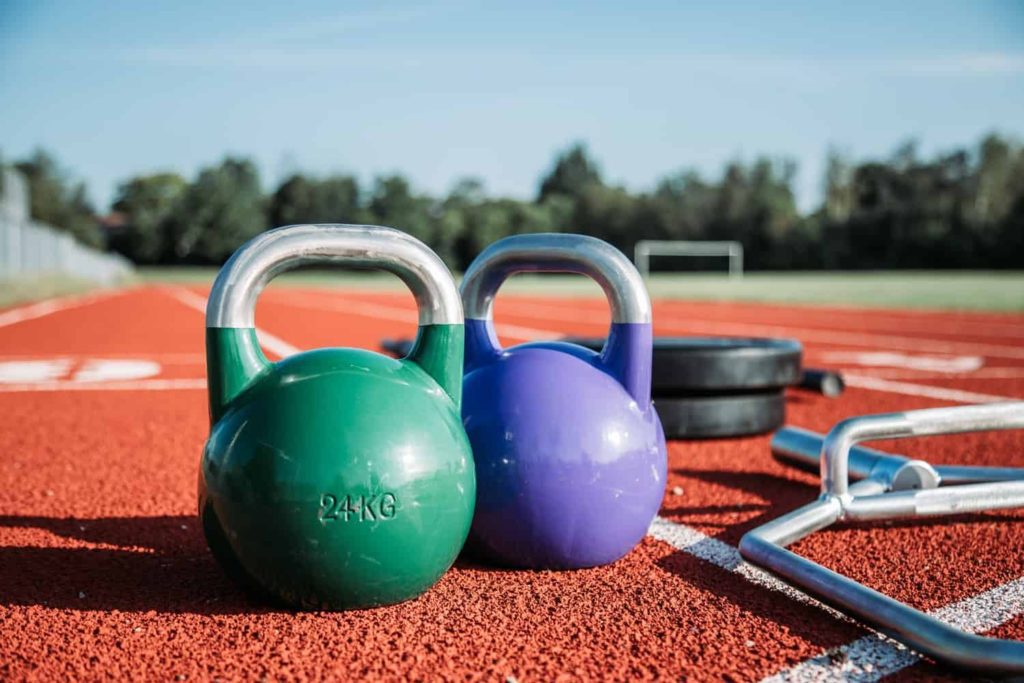If the pandemic taught us anything, it’s that having everything you need at home can be a lifesaver – including your gym! The issue is that, for most people, we simply don’t have the space to have all the gym equipment we need to get in a good workout. This is where kettlebells come in – they’re small enough to fit in any space while also offering a full-body conditioning experience. Whether you’re looking to tone, build muscle, or get your heart rate up, you’ll find a kettlebell workout that can deliver the results you want.
Why Incorporate Kettlebells In Your Workouts?
A kettlebell, usually made from steel or iron, is essentially a weighted ball with a handle. They can range from four pounds to 175, which means they offer the same variety in weights as dumbbells. Unlike dumbbells, however, they have one center of gravity – found in the ball – while dumbbells have the weight displaced on either end of the handle. This difference is what uniquely positions kettlebells to provide both a strength and balance challenge. This is also why a kettlebell can feel heavier than a dumbbell of the same weight
The unique design of the kettlebell provides many benefits during a workout, including:
- Improve cardiovascular system: You can use kettlebells to do a dynamic workout that requires you to use multiple muscle groups at once, including moves where you hold the kettlebell overhead. These challenging moves easily elevate your heart rate and get you into a fat-burning state.
- Burn calories: When you choose to do a dynamic, total body workout with your kettlebells, you torch calories. For example, doing kettlebell swings can burn up to 20 calories per minute – you could burn about 200 calories in just 10 minutes of work. While you can’t target a specific place to burn fat, you can burn fat all over the body, which means that you can indeed use kettlebells to burn belly fat.
- Build strength: Kettlebells provide you with the same freedom to train as free weights. You can target any area of the body and build strength according to your goals by amping up weight and reps.
- Increase forearm and grip strength: Since the center of gravity of the kettlebell moves with your grip, you get a mix of static and dynamic muscle contractions, leading to increased forearm and grip strength. The handle itself is thicker than the average dumbbell, so adjusting to the size will also improve your grip.
- Challenge core stability and stength: The kettlebell offers multiplanar movements, which means you can work your core from every single direction. Lots of kettlebell exercises are also ballistic, meaning you maximize acceleration and minimize deceleration. This explosive power and control is a serious challenge for your core and stability, requiring that you contract your abs and zero in on breathing with the movement.
- Reduce back pain: Many of the ballistic movements done with kettlebells are completed from a hinge position, working your posterior chain – the muscles that run along the backside of your body. Lower and middle back, hamstrings, glutes, and traps are challenged with these movements. By working these muscles, you’ll build back strength and reduce back pain.
- Control diabetes: High-intensity workouts, like those you can do with kettlebells, are great for overall health, but recent studies have shown that they can be especially effective for lowering glucose and helping you control diabetes.
Three Total Body Kettlebell Exercises
You can use kettlebells much like a dumbbell for most strength exercises – lunges, squats, biceps curls, tricep presses, and more. These are great exercises to incorporate into your weekly routine. However, you can increase the challenge by trying out the following total body burners.
Kettlebell Swings
With your feet shoulder-width apart, stand tall and grip the handle of the kettlebell with both hands. Lightly bend the knees, hinge at the hips, and swing the kettlebell between the legs, keeping your back flat as your torso lowers. Drive your hips forward, bringing yourself back upright and allowing the momentum of the hips to swing the kettlebell to chest height, arms locked straight. Repeat again and again, using the momentum of the kettlebell and your hips to drive you.
Figure 8s
Stand feet shoulder-width apart, gripping the kettlebell with one hand. Like a kettlebell swing, bend the knees and hinge the hips back, allowing the kettlebell to go between the legs. Catch the kettlebell with your other hand behind the body, grabbing the handle and releasing your initial hand. Stand up as you bring the weight around your side to the chest, handing it off again to the original hand at the chest, to complete one rep.
High Pull Sumo Deadlifts
Holding the handle with both hands, hinge at the hips and keep the back straight as you lower the weight toward the ground. When you feel your hamstrings engage, squeeze your butt to stand up straight – as you do, bring the elbows up, pulling the weight toward your face and engaging the shoulders and back. Lower the weight to the starting position and repeat.
As with any other equipment, it can take some practice to learn new routines and proper form with kettlebells. It’s an adjustment well worth the effort, as kettlebells take up little space while also offering you a full-body, stability, strength, fat-burning, and cardio workout. Are you up for the challenge?

If you would like news programs for training with Kettlebells , click on the link


